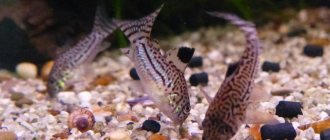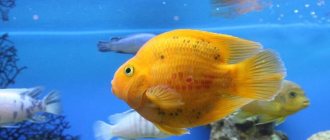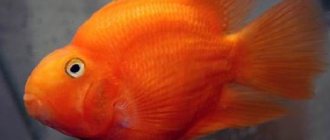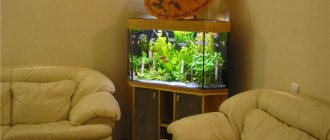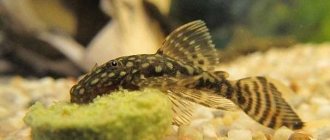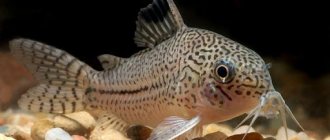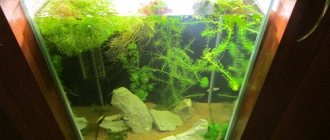We have selected for you detailed information on aquarium catfish: their appearance and characteristics of behavior, maintenance and reproduction.
| Full name | Soma/Silurus |
| Kinds | Otocinclus, ancistrus, albino, star ancistrus, pterygoplichthus, hypancistrus, loricaria, elegant, speckled, black-bellied pinnate, multispot pinnate, angel, synodontis, platidoras striped, agamixis star or white-spotted, tarakatum, corydoras, flathead or farctocephalus, red-tailed |
| Color | Black, white, silver, brown, beige, often with spots and stripes |
| Water | PH (acid-base balance) – 5-7 KH (hardness) – 6-12° t (temperature) – 22-28 °C |
| Feed | Dry: Tetra Wafer Mix, Sera Wels Chips, Sera Vipachips Nature, Zoomir Granules for bottom fish and amphibians; live food is not recommended due to the possibility of helminth infection |
| Compatibility | Guppies, gouramis, danios, barbs, angelfish, swordtails |
| Lifespan | Average 8 years |
Description and habitat
Catfish spend most of their lives at the bottom of the reservoir. These fish can be carnivores and vegetarians, but most are omnivores.
They inhabit freshwater bodies of all continents except Antarctica.
Appearance
Catfish are fish with a large head with several pairs of antennae and a relatively flat body that tapers to a tail. The color of catfish is quite varied, but most have neutral shades, close to the color of the bottom.
Their sizes are varied: from a couple of centimeters to huge “monsters” of several meters. Their appearance and behavior are quite funny, so they are often kept in aquariums.
Features of behavior
In addition to the fact that the presence of catfish enlivens the lower part of the exhibition, they maintain its cleanliness by eating food that has fallen to the bottom of the aquarium. Many of them help get rid of algae by scraping it off the inside surfaces of the aquarium with their suction cup mouth.
Reviews
Aquarists speak positively about golden ancistrus, because they are unpretentious and peaceful neighbors for other inhabitants. They also allow you to less frequently clean the walls of aquariums from algae and reproduce easily. But sometimes cases occur when catfish spoil the thin leaves of a plant. Some aquarists are also upset that the catfish rarely comes out into the light, hides in shelters all the time and is active only at night.
Kinds
Catfish are an extremely numerous family, including approximately 2000 species. It is possible to create conditions for maintaining a significant part of them at home - the limitations are mainly due to size.
Chain group or loricariaceae
This group includes almost 700 species, but only a few of them are suitable for home keeping.
All loricaria have an elongated body and a pointed tail. Their body is covered with thickened bone plates, which have an external and functional resemblance to chain mail. The sizes of loricaria range from 10 to 30 cm.
The head has a triangular shape, the mouth has turned into a suction cup, allowing the fish to scrape off algae while staying in rivers and streams with strong currents.
Chainmails are found naturally in Central and South America, especially densely populating the Amazon basin.
Otocinclus
Otocinclus range in size from 2 to 5 cm. The body is elongated.
Color depends on the species. They usually have a silver body with a yellow tint, covered with dark spots. A dark stripe may run along the entire body. Otocinclus zebra, on the contrary, has a transverse
Ancistrus
Ancistrus catfish is a rather large aquarium fish, up to 20 cm. The color is dark with a mass of white dots and a white border on the fins. In young individuals the pattern is most pronounced.
Stellate Ancistrus
The star-shaped variety of Ancistrus is valued for its smaller size compared to the ordinary one - it does not exceed 8 cm. Its body has a black background and bluish-white “stars” that darken with age.
Pterygoplichthus
Pterygoplichthus has a size of up to 25 cm, but is extremely peaceful and feeds exclusively on plant foods. The large dorsal fin in the shape of a sail with twelve rays gives it an interesting appearance.
The body color is leopard - a beige pattern on a chocolate-black background. There are albinos.
Hypancistrus
Hypancistrus have a drop-shaped body with a specific “hump” on the head and elongated rays on the tail. Sizes from 8 to 16 cm.
Coloration varies from gray-green to black with contrasting spots or stripes of white, yellow or orange depending on the species.
Pinnate group or synodonts
Synodonts are divided into 131 species. They all live in Central, East and West Africa.
Their length is from 6 to 70 cm. They have a strongly laterally compressed head with a wide mouth, large eyes and crown pairs of mustaches. The body is massive, laterally compressed, without scales, but covered with mucus. The tail is elongated, largely cut.
The color ranges from off-white to black. The main background has a pattern of spots or stripes of a contrasting color - black, white, red or brown, the tail is also edged. The belly is darker and more monochromatic.
Black-bellied pinnate
The length of this catfish reaches 5 cm. The coloring is interesting: dark stains, similar to a marble pattern, on a whitish or beige background. The abdomen is almost black.
Multispotted pinnate
Its dimensions reach 12 cm. The color is spotted, characterized by a dense black pattern on a yellowish background. The tail has a black edge, the remaining fins are white and blue in the back.
Angel
This catfish can grow up to 25 cm. It has a polka dot color - light or reddish spots on a dark bluish-gray background. The fins are brindle in color.
Synodontis catfish changeling
The aquarium fish catfish, the shifter, swims with its belly up most of the time. It has a size of no more than 10 cm. The color is camouflage - dark spots on a brownish-gray background.
Armor group or singing catfish
The entire body of these catfish is covered with large bony plates, and the sides are covered with spines. Only the belly, on which the catfish lies, is not protected. Also, when stressed, they can secrete toxic mucus.
This group lives in South America and has 90 species. All of them are distinguished by their ability to make sounds due to the movements of the spines on the fins or the vibration of the swim bladder.
Their sizes range from 3.5 to 120 cm.
They have needles in several fins, the wounds of which do not heal well. Therefore, you should be careful when catching and transporting.
Platydoras striped
This catfish reaches 20 cm. The body is dark brown in color with two light yellow stripes along the back. The head below, belly and fins are colored light yellow, while the dorsal fin has an oblique dark brown stripe.
Agamixis star or white-spotted
This species can grow up to 14 cm. Its body and fins are covered with white or yellow spots, which merge into 2 rows of transverse stripes closer to the tail, on a black-brown background.
Bargus or killer whale group
This is a large family, native to Africa and Asia, with 227 species. The fish are predatory, with a characteristic body shape. They do not have scales; their body is protected by mucus. The dorsal fin has one spiny fin and up to 20 soft rays.
These are medium-sized fish, up to 20-40 cm. The body color is usually black or silver, with stripes and spots.
Armorate or callicht group
This family contains about 160 species, 130 of them belong to the genus Corydoras. They are widespread in South America. It got its name from the rows of bony plates that cover the entire body. The sizes of these fish vary from 2 to 16 cm.
Most of them live in swampy and silty bodies of water, with little oxygen in the water. And although they lead a bottom-dwelling lifestyle, to breathe they rise to the surface of the water and swallow atmospheric air through their mouths. These fish feed mainly on small invertebrates.
The coloring is not very varied in color, but there are interesting variations of patterns. For example, the corydoras panda has characteristic spots around the eyes and near the tail.
Elegant catfish
This catfish grows up to 5 cm. The color is gray with dark speckles, which extends to the dorsal fin. Two light stripes run along the body. The tail and all other fins are translucent.
Corydoras speckled
This corridor has a size of up to 7 cm. The color is olive-gray with darker spots of different sizes. The abdomen and fins have no pigmentation. There is an albino form.
Tarakatum
This name comes from "shell" in Latin. This catfish can grow up to 15 cm.
Its color ranges from marsh to hazel, with black spots all over its body. The abdomen is lighter, usually beige.
Pymelodovaya or flathead group
This group lives in Central and South America and has about 300 species.
Most of them are medium and large in size, some are over two meters.
The body has no scales. The head is decorated with three pairs of antennae; in some species they are comparable to the length of the body.
Many have bright and variegated colors. Juveniles can differ significantly from adults in color and body shape.
Red-tailed
In the wild it can reach a length of 175 cm, and in aquariums it is one of the largest fish.
The name comes from the bright orange or red tail fin. The body is dark gray with black spots. Along its sides there are wide white stripes.
He is very voracious, you cannot keep small fish or even small decorations with him - he can mistake all this for food and swallow it.
Behavior in the wild
The South American representative of freshwater fauna, Agamix speckled, lives in the upper reaches of the Amazon, in the Venezuelan Orinoco River, as well as in Brazilian and Peruvian lakes. It prefers to settle in clean bottom layers of shallow water with calm, warm water and a densely overgrown shore.
It is active at night. During the daytime it hides between stones and under snags. It feeds on mollusks and snails.
Agamix belongs to the bottom representatives of aquatic fauna, therefore it prefers clean water with an average flow speed
Surprisingly, these fish have the ability to move on their powerful fins on land to bodies of water located close to each other.
If there is not enough oxygen in the water, they rise to its surface. These catfish have both gill and intestinal respiration. This is how they make up for the lack of oxygen.
Agamix spawns during the rainy season; the female is capable of laying from 2 to 3 thousand eggs per spawning.
How to choose catfish
Catfish are very diverse both in nature and in the aquarium. But when buying a specific species, you need to have a good idea of its size as an adult, habits and features of keeping.
Dimensions and physical shape
Moreover, the size of catfish is one of the most important indicators. The same red-tailed catfish, for example, is often found on sale with a size of 5-8 cm and attracts attention with its bright decorative coloring. But how many are ready for the fact that he can grow up to 1.4 meters and reach a weight of 45 kg?
It is also necessary to pay attention to the appearance of the fish. Many of them may seem quite thin. This is normal - when transporting fish, they feed very little. But the stomach should not look very sunken.
The coloring of catfish should be uniform and bright, the skin should be smooth and free of plaque, and the fins should be intact.
Particular attention should be paid to the antennae of these fish. They should not bleed or be shortened. This is a sign of poor maintenance, in which the catfish’s whiskers are the first to suffer.
Behavior
If you plan to add catfish to other fish in a community aquarium, you need to study their habits. Even outwardly similar catfish can be either peaceful or more aggressive. And we must not forget that many of them are predators, including those capable of swallowing fish larger than their size.
How to distinguish a female from a male
Female catfish are larger in size and have a rounded abdomen. Males are brighter and more variegated in color, have larger fins and a greater number of growths and antennae.
Near the anus, males have a protruding tubercle, and females have a depression.
Transportation home
Usually fish are transported in plastic bags with water. But it is better to transport aquarium catfish in double bags, and large species even in triple bags. They often have sharp spines on their fins that can easily pierce a bag. Better yet, use plastic containers.
Diet of black bagus
Despite its predatory habits, feeding the black bagus is not very difficult. The basis of his diet can be the following products:
- shrimp meat;
- pieces of fillet of any white-meat fish.
They eat worms or bloodworms only at a young age, and as they grow older they prefer larger prey. Over time, they become accustomed to eating catfish tablets and plates.
Some enthusiasts go to natural reservoirs in the spring and summer and catch tadpoles for bagrus. Catfish really love this kind of feeding. But it is important to understand that dangerous parasites or infections can be brought into the aquarium from a natural reservoir.
If black bugs are kept in a species aquarium, from time to time you can keep them in good shape by throwing in rejected small fish - guppies, mollies, substandard fry, etc. Catfish will be happy to hunt, and their instincts will be satisfied.
- You need to feed the catfish in the evening, once a day. Sometimes this is done shortly before the lights turn off. In other cases - after switching the lighting to night mode.
Selection and arrangement of an aquarium
All aquarium catfish are bottom-dwelling fish. Therefore, it is not so much the size of the aquarium that matters, but the area of its bottom. In this case, height is not so important.
The length is important if it is necessary to create a strong current in the aquarium, which is necessary for some species, for example, loricariids. In this case, it is better to take a longer aquarium.
Round aquariums are not suitable for catfish. The fish are uncomfortable in them, plus the installation of equipment also causes difficulties.
Volume
The capacity of the aquarium depends on the size of the fish themselves, plus their number is important. In general, for 2-7 centimeter small catfish, a volume of 50–200 liters is sufficient, and for half-meter ones it should exceed 500 liters.
Equipment
Many catfish in nature live in flowing water with a strong current, rich in oxygen. Therefore, in aquariums with them, filters are often used to create water flows. Aerators (for example, compressors) are less important, since catfish often use atmospheric air for breathing.
To clean the bottom, it is better to use a mechanical bottom filter. All catfish dig the soil and raise streams of mud.
It is better to mount all filters outside the aquarium. Many catfish can move fairly large objects. If the equipment is located on the inside, it must be well secured. Separate submersible filters combine aeration and filtration and can also be used.
Many catfish are heat-loving, and they need additional heating of the water. In such cases, you will need to purchase a water heater and a thermometer. Moreover, it is better to choose the latter so that it is attached to the outside of the aquarium wall - otherwise the catfish will simply tear it down.
Lighting
Catfish fish are aquarium bottom dwellers, and they do not need bright light. They do not require additional lighting; moreover, the aquarium with catfish must be shaded. And under no circumstances should you place it near a window or near light sources.
The light should be dim and diffused - then the catfish will be active not only at night, but also during the day.
Water parameters
The water temperature for most catfish species should be between 22-28 °C. At the same time, it should have neutral acidity and hardness of 6-12°.
Priming
The best soil for catfish is coarse sand or gravel. Digging in shallow soil, they will raise turbidity.
The substrate must be smooth, without sharp edges or jagged edges. Otherwise, aquarium catfish can damage their muzzle and antennae when searching for food.
Plants
For an aquarium with these fish, plants are a must. They will create partial shade, which catfish love so much. For this role, you need to choose plants with large leaves and strong roots, plus you need to further strengthen them, since catfish will dig them up.
Scenery
The presence of hiding places should be important in an aquarium. These can be driftwood, stumps, turrets, houses, grottoes or caves, ships, groups of stones, ceramic pots, pipes and shards, coconuts and shells. It is important that there is at least one shelter for each fish. There they will hide and rest.
Content
Catfish are unpretentious, which attracts many aquarists. It is enough to provide them with standard conditions so that they are healthy and active.
What and how to feed?
Most of these fish are omnivores, and happily consume both live and frozen food, as well as dry and freeze-dried food. Their diet should contain both plant and animal foods. Feeding many species with raw fish, seafood, vegetables and herbs is allowed
Lifespan
The largest representatives in nature can live up to 100 years. But they don’t keep them at home; on average, aquarium catfish live for 8 years, but a lot depends on the variety and content.
Compatibility with other fish
When buying any aquarium fish, you need to know who they get along with, because each has its own characteristics.
Most catfish are peaceful, do not start fights with representatives of other species, but sometimes they come into conflict with each other. The greatest threat is posed by large fish that can swallow their prey whole.
It is also undesirable to introduce them to fish that have a habit of biting off their tails.
Compatibility
The corridors are very peaceful and cute fish. It is not in their interests to offend or attack someone. Therefore, keeping them with large fish or even small cichlids is not the best option.
As a rule, these catfish are kept in schools of 5-6 with small and peaceful fish. An excellent company would be:
- Neons
- Tetras
- Guppy
- Pecilia
- Angelfish
- Danio
Of course, this is not the entire list, but if we take it as a whole, then viviparous, small characins are best friends
